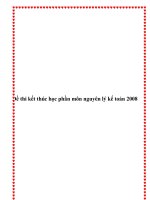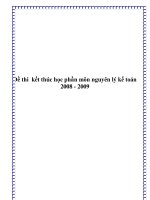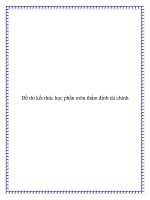ĐỀ THI KẾT THÚC HỌC PHẦN MÔN LÝ THUYẾT DỊCH
Bạn đang xem bản rút gọn của tài liệu. Xem và tải ngay bản đầy đủ của tài liệu tại đây (106.66 KB, 21 trang )
<span class="text_page_counter">Trang 1</span><div class="page_container" data-page="1">
<b>TỔNG HỢP ĐỀ CƯƠNG ĐỀ LÝ THUYẾT DỊCH</b>
<i><b>Trường: Đại Học Ngoại Ngữ- Đại học Đà NẵngĐề thi kết thức học phần </b></i>
</div><span class="text_page_counter">Trang 2</span><div class="page_container" data-page="2"><b>I. Decide whether each of the following statements is true or false, then make a tick (✔) in the appropriate box. (2 marks)</b>
1 TL readership should be considered prior to translation 2 Textual equivalence means equivalence of form and shape. 3 Sameness does exist between the SL text and the TL version 4 Adaptation is mainly applied to plays and poems.
5 A translation can be primarily semantic or primarily communicative. 6 Intra-lingual translation is translation within the same language 7 Translation and interpretation involve ideas, not words.
8 Communicative translation and semantic translation are always separated methods.
9 Connotation is not important in doing translation.
10 Gain in translation results from enrichment or clarification of the source language text.
<b>II. Answer the following questions. (3 marks)</b>
<i><b>1. Explain why “a good translator/interpreter has to be a veritable mine of information.”</b></i>
<i><b>2. What is a prerequisite for study in translation and interpretation?</b></i>
<i><b>3. What is consecutive translation?</b></i>
<i><b>4. Name the three laws of translation formulated by Tytler (1978).</b></i>
</div><span class="text_page_counter">Trang 3</span><div class="page_container" data-page="3"><i><b>5. What is denotative meaning?</b></i>
<i><b>6. Name two types of untranslatability</b></i>
<i><b>7. Name six principles of translation.</b></i>
<i><b>8. What does “interlingual translation” mean?</b></i>
<i><b>9. Give an example of cultural untranslatability and explain why.</b></i>
</div><span class="text_page_counter">Trang 4</span><div class="page_container" data-page="4"><i><b>10. What are the striking differences between the two methods of translation: semantic translation and communicative translation?</b></i>
<b>III. Fill in each of the gaps in the following passage with ONE word. (2 marks)</b>
• A good translator/interpreter must not only be ___________ in the languages to be used but also be well-equipped with abundant _____________ _____ ________ of fields. He or she must grasp the _____________ _____________ which formulated those ideas. In addition, specific translative or interpretive _____________ are also required.
• Translation implies carefully analyzing the message given within the __________ of a particular linguistic code and transferring this message into another ___________ linguistic code. Interpretation, on the other hand, means doing the _____________ ________ _____.
</div><span class="text_page_counter">Trang 5</span><div class="page_container" data-page="5"><b>IV. For each of the following translation procedures, give TWO similes in English plus their Vietnamese translational equivalents. (1 mark)</b>
Reproducing the same image in the target language
Replacing the image in the source language with a standard target language image
</div><span class="text_page_counter">Trang 6</span><div class="page_container" data-page="6"><b>V. Translate the following sentences into Vietnamese by using the semantic translation (ST) method and the communicative translation (CT) method respectively. (2 marks)</b>
<i><b>1. There remained very little of their house after the horrifying tsunami.</b></i>
</div><span class="text_page_counter">Trang 7</span><div class="page_container" data-page="7">1. Source language (SL) means the language of the __________ text. 2. Target language (TL) means the language of the ___________text.
3. Newmark’s definition of translation focuses on _________ the meaning of the text,
4. As claimed by Tudor, there are two barriers concerning _________and __________ in the process of translation.
5. Sight translation differs from _____________translation in the speed of response. 6. ……….. translation is entirely based on the source language.
7. Cabin translation is often used to stand for ________________ translation. 8. Semantic translation includes a literal and _______________ translation.
9. Communicative translation produces a more_________________ way of translation. 10. Language is the ……….. within the body of culture
</div><span class="text_page_counter">Trang 8</span><div class="page_container" data-page="8">11. An overlapping method of translation is the combination between _________ and
<i><b>16. Of the three words "slim, slender, skinny", the word "slender" has a more __________ connotation. 17. By retaining the image, the metaphoric expression of "ray of hope" can be rendered into Vietnamese as </b></i>
</div><span class="text_page_counter">Trang 9</span><div class="page_container" data-page="9">21. The purpose of the translation is to transfer the __________ structure of the SL into the TL. 22. The process of translation, as claimed by Ian Tudor, involves dealing with 2 barriers
<i><b>23. _________________ Translation is entirely based on the source language. </b></i>
<i><b>24. The communicative translation of “Coi chừng! Cửa mới sơn” can be “______________ </b></i>
<i><b>28. The rendering of the advertising slogan “Canada- The big country for big value holidays” into “Canada- </b></i>
Miền đất lễ hội” is an example of………. in translation.
<i><b>29. “ A man is known by the company he keeps” can be idiomatically rendered in to Vietnamese as </b></i>
“_______________ ____________ ____________ _______________”.
<b>DỊCH ĐOẠN VĂN MÔN LÝ THUYẾT DỊCH</b>
</div><span class="text_page_counter">Trang 10</span><div class="page_container" data-page="10"><i><b>PART B:Trang 13:</b></i>
We all want success. We want to be successful and feel successful. We chase money, fame, power, education, relationships and a thousand other things without ever stopping to ask one essential question: What, actually, is success?
Few people pause to consider what it truly means to achieve success in their own lives. As Jim Rohn said, "If you don't design your own life plan, chances are you'll fall into someone else's plan. And guess what they have planned for you? Not much."
</div><span class="text_page_counter">Trang 11</span><div class="page_container" data-page="11"><i><b>Trang 17:</b></i>
Before we can pursue success, we need to understand what success isn't. If you spend just a few minutes on social media, you'll realize how many people hold a very narrow definition of success. They think it's about building wealth, having the perfect relationship, or launching a billion-dollar business. And a lot of times, they attach famous people to their image of success.
</div><span class="text_page_counter">Trang 12</span><div class="page_container" data-page="12">None of these things or people is wrong but being like them doesn't negled to the top only to feel miserable and fought and make you successful. Many people have burned out once they get there. They're unhappy because they pursued the wrong definition of success - one that didn't match their
Throughout childhood and early adulthood, we learn various ideas of success from our parents, teachers and friends. Everyone has their own agenda and idea of who and what we should be. Although it's OK
</div><span class="text_page_counter">Trang 13</span><div class="page_container" data-page="13">to value the opinions and hopes of others, we shouldn't necessarily adopt them as our own. No one can impose their version of success on us. No one can tell us what it means to live the good life.
It's easy to assume that success means obtaining a specific object, such as a job or social status, and to believe that if we get that thing, we'll be successful. But some of the greatest successes resulted from the
</div><span class="text_page_counter">Trang 14</span><div class="page_container" data-page="14">worst failures. Winston Churchill said, "Success is not final, failure is not fatal. It is the courage to continue that counts."
Most of us probably don’t believe we need a formal definition of happiness; we know it when we feel it and we often use the term to describe a range of positive emotions, including joy, pride,
contentment, and gratitude. To many people, happiness is having fun at a party, the excitement of new experiences, or the delights of a fine meal. These are all wonderful experiences to be cherished but they
</div><span class="text_page_counter">Trang 15</span><div class="page_container" data-page="15">are not happiness. These experiences are the definition of pleasure. They are experiences to have and let pass. A meal to savor, then digest. A party to enjoy then let wind down. If happiness is not the same thing as pleasure, then what is happiness? Happiness is when your life fulfills your needs. It can most certainly be found- and not just momentary pleasure, but genuine, long-lasting happiness. In fact, most people have to work very hard for a very long time to finally find happiness. It is not unattainable. Happiness can happen to anyone, mostly because everyone deserves to be happy.
V.Translate the following advertizing slogans into Vietnamese. 1. Apple: Think Different. ………
</div><span class="text_page_counter">Trang 16</span><div class="page_container" data-page="16">2. Kentucky Fried Chicken: It’s Finger Lickin' Good.
<i><b>1. Defining translation: Translation is the process of coveying messages across linguistic </b></i>
<i>and cultural barriers</i>
<b>2. Types of translation:</b>
- Intralingual translation: (nội ngữ) translation within the same language, which can involve rewording or paraphrase
- Interlingual translation: (liên ngữ) translation from one language to another
- Intersemiotic translation: (liên kí hiệu) translation of the verbal sign by a non-verbal sign. Eg: music, image, braille (chữ nổi)
<b>3. Prerequisite for study in translation and interpretation:</b>
- General knowledge - Cultural knowledge
- Specific translative/interprective skills
<b>4. Requirements for doing well in translation and interpretation:</b>
- A good translator/interpreter has to be a veritable mine of information no matter what subject he is dealing with you have understand what the author is really saying.
- You must first understand the ideas behind the words and going on step further, you should have clear knowledge of the culture which formulated those ideas.
</div><span class="text_page_counter">Trang 17</span><div class="page_container" data-page="17"><b>5. Definition of Translation versus Interpretation:</b>
Translation implies carefully analyzing the message given within the context of particular linguistic code and transferring this message into another written linguistic code.
Interpretation, on the other hand, means doing the same but orally and simultaneously.
<b>6. Four basic types of T and I:</b>
- Prepared translation: biên dịch có chuẩn bị
- Sight translation: dịch nhìn văn bản (speed of response) - Consecutive interpretation: dịch đuổi
- Simultaneous interpretation: dịch song song/đồng thời/cabin
<b>7. The training for developing the skills of Consecutive interpretation:</b>
1. Learning to repeat what a speaker has said, first in one’s dominant language
Context is that which accurs before or after a word, a phrase or even a long utterance or text. The context often helps in understanding the particular meaning the word, phrase.
<b>9. Four types of text by Peter Newmark</b>
- Narative: a dynamic sequence of events with emphasis on verbs, verb nouns or phrasal verbs. - Description: static, with emphasis on linking verbs, adj, adj noun
- Discussion: a treament of ideas, with emphasis on abstract nouns (concepts), V of thought, metal activity, logical argument and connectives.
- Dialogue: with emphasis on colloquilisms and phaticisms
<b>10. Six principles of translation:</b>
<i><b>a) Meaning: the translation should reflect accurately the meaning of original text. Nothing should </b></i>
be arbitrarily added or removed. Ask yourself:
- Is the meaning of original text clear? If not, where does the uncertainty lie?
- Are any words “loaded”, that is, are there any underlying implications? (‘correct me if I’m wrong..’ suggests ‘I know I’m right’)
- Is the dictionary meaning of a particular word be most suitable one - Does anything in the translation sound unnatural or forced?
<i><b>b) Form: should match the originals closely as possible.</b></i>
<i><b>c) Register: The translator must distinguish between formal or fixed expressions and personal </b></i>
expressions in which the writer or speaker sets the tone.
- Would any expression in the original sound too formal/informal, cold/warm, personal/impersonal… if translated literally?
- What is the intention of the speaker or writer? (to persuade/dissuade, apologize/criticize? Does it come through in the translation?
<i><b>d) Source language influence: a good way of shaking off the SL influence is to set the text aside </b></i>
and translate a few sentences aloud, from memory. This will suggest natural patterns of thought in the first language which may not come to mind when the eye is fixed on the SL text.
</div><span class="text_page_counter">Trang 18</span><div class="page_container" data-page="18"><i><b>e) Style and clarit: The translator should not change the style of the original. But if the text is </b></i>
sloppily written, or full of tedious repetitions, the translator may, for the readr’s sake, correct the defects.
<i><b>f) Idiom: idiomatic expressions are notoriously untranslatable (similes, metaphors...) if the </b></i>
expressions cannot be directly translated try any of the following: - Retain the original word, in inverted commas
- Retain the original expression, with a literal explanation in brackets: - Use a close equivalent
- Use non-idiomatic or plain prose translation
<i><b>If the idiom does not work in the L1, do not force it into the translation </b></i>
<b>11. The notions "language" and "culture". Explain why translation and culture are intimately connected . ( p.25 )</b>
Language is a set of verbal symbols that are primarily auditory.
Language also constitutes the most distinctive feature of a culture , which may be described in a simplistic manner as the totality of the beliefs and practices of a society . And although a language may be regarded as a relatively small part of a culture , it is indispensable for both the functioning and the perpetuation of the culture .
<i><b>Because culture gives birth to language , translation and culture are intimately connected . </b></i>
Meanings in both source and target languages are profoundly affected by their cultural context , especially in business translation. A phrase that appears easy to translate may actually contain cultural subtleties that, unless they are accounted for , can bring just the opposite meaning than is intended. So, translation without deep cultural context can be dangerous , especially when meanings are critical.
<b>12. Connotative meaning and denotative meaning. Give ex for illustration(p.29)</b>
<i><b>Connotative meanings refer to the additional meanings that a word or phrase has beyond its central meaning ( = denotative meaning ) , these meanings show people's emotions and </b></i>
attitudes towards what the word or phrase refers to .
<i><b>For example : " run " may suggest " haste " " sofa " may suggest " comfort " </b></i>
<i><b> and " tropic " may suggest " heat "</b></i>
<b>13. Four types of translational equivalence . ( p.31 )</b>
<i><b>(1) Linguistic equivalence, where there is homogeneity on the linguistic level of both SL and TL</b></i>
text, i.e. word for word translation
(2) Paradigmatic equivalence, where there is equivalence of “ the elements os a paradigmatic
<i><b>expressive axis”, i.e. elements of grammar, which Popovic sees as being a higher category </b></i>
than lexical equivalence.
<i><b>(3) Stylistic ( translational) equivalence, where there is “functional equivalence of elements in </b></i>
both original and translation aiming at an expressive identity with an invariant of identical meaning”.
<i><b>(4) Textual (syntagmatic) equivalence, where there is equivalence of form and shape.</b></i>
<b>14. Two types of untranslatability . ( p.33 ) </b>
<i><b>LINGUISTIC UNTRANSLATABILITY , he argues , is due to differences in the SL and the TL, whereas</b></i>
<i><b>CULTURAL UNTRANSLATABILITY is due to the absence in the TL culture of a relevant situational feature for the SL text</b></i>
</div><span class="text_page_counter">Trang 19</span><div class="page_container" data-page="19"><b>15. Loss and Gain in translation ( p . 35 ) </b>
Loss: The disappearance of certain features in the TL text which are presented in the SL text .
Gain: The enrichment or clarification of the source language text in the process of translation .
<b>16. Translation methods ( p . 36-38 ) .</b>
<b>1. Word - for - word translation </b>
This is often demonstrated as interlinear translation , with the TL immediately below the SL words . The SL word - order is preserved , and the words are commonly translated singly out of context . This is often used as a pre - translation process to understand the mechanics of the SL text .
<b>2. Literal translation </b>
The SL grammatical constructions are converted to their nearest TL equivalents , but the lexical words are still translated singly , out of context . As a pre - translation process, this indicates the problems to be solved . An example of literal translation could be the rendering of ' Give me a hand ' Clinto Đưa cho tôi một tay ’ in Vietnamese whereby the rendering of Give into Dua is out of context, which means a clumsy , thus irrelevant translation of words in context .
<b>3. Faithful translation </b>
A faithful translation attempts to reproduce the precise contextual meaning of the original within the constraints of It the TL grammatical structures . ' transfers ' cultural words and preserves the degree of grammatical and lexical ' abnormality ' ( deviation from SL norms ) in the translation . Translation of this type attempts to be completely faithful to intention of SL writer.
<b>4. Semantic translation </b>
Semantic translation differs ' faithful translation ' only in as far as it must take more account of the aesthetic value ( that is , the beautiful and natural sound ) of the SL text ,
compromising on ' meaning ' where appropriate so that no assonance , wordplay or repetition jars in the finished version Further , it may translate less important cultural words by
culturally neutral third or functional terms but not by cultural equivalents . The distinction between ' faithful ' and ' semantic ' translation is that the first is
uncompromising and dogmatic , while the second is more flexible , admits the creative exception to 100 % fidelity and allows for the translator's intuitive empathy with the original . Thus , the example given earlier ' Give me a hand ' would be more semantically rendered into ‘ Hãy giúp mình một tay ’ , which allows for more natural sound of the TL text .
<b>5. Adaptation </b>
This is the ' freest ' form of translation . It is used mainly for plays ( comedies ) and poetry : the themes , characters , plots are usually preserved , the SL culture converted to the TL culture and the text rewritten by an established dramatist or poet .
<b>6. Free translation </b>
Free translation reproduces the matter without the manner , or the content without the form of the original . Usually , it is a paraphrase much longer than the original , a so - called ' intralingual translation ' , not a real translation at all .
<b>7. Idiomatic translation </b>
</div>








